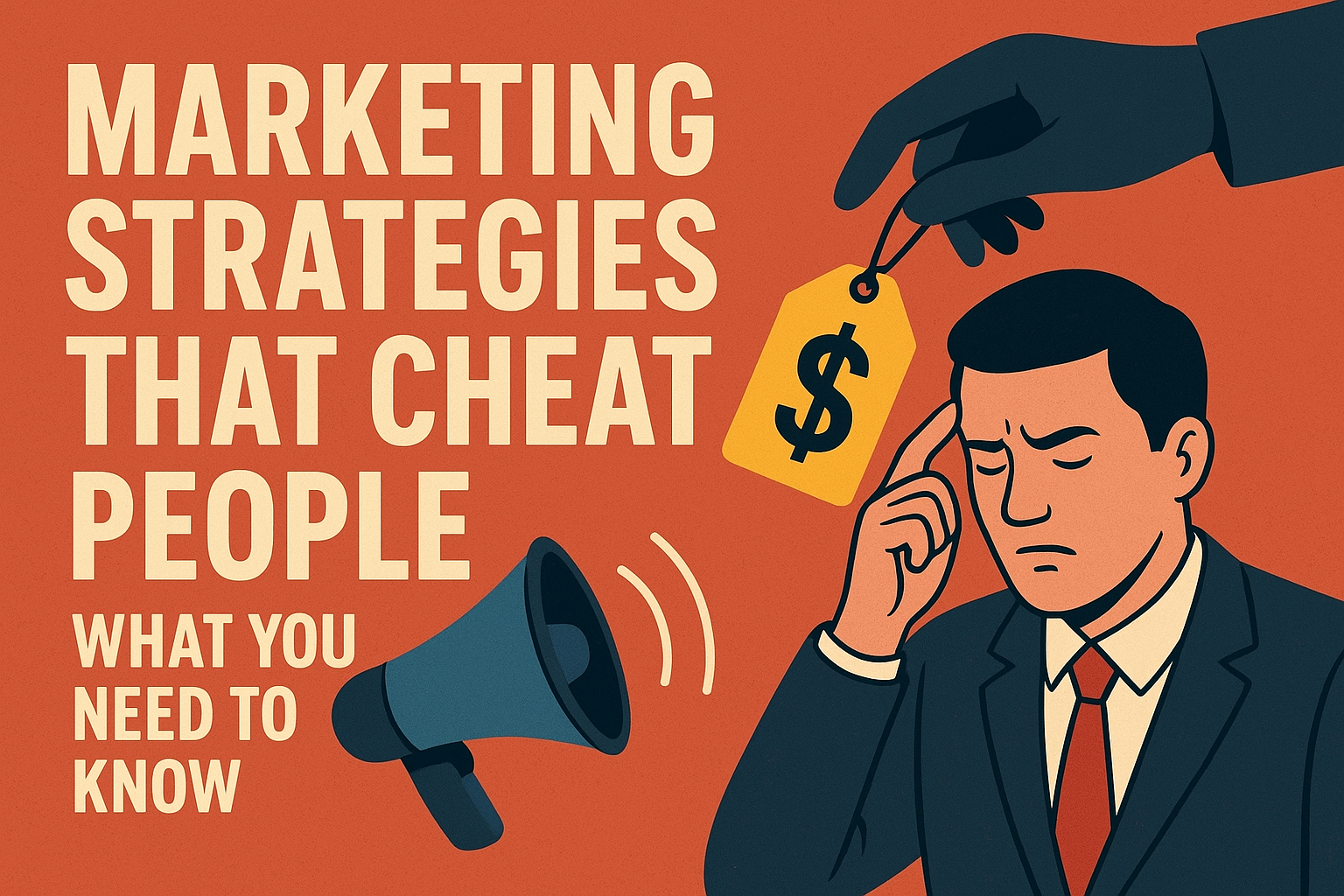
Zahra
In today’s fast-paced world, marketing is everywhere. From the moment we wake up and scroll through our phones to the billboards flashing on the streets, brands are constantly competing for our attention. Marketing, in itself, isn’t bad it helps businesses grow and helps customers discover useful products. But there’s a darker side to it. Many companies use psychological tricks designed not just to attract you, but to manipulate your emotions and habits, often leading you to spend more than you planned.
This article explores the most common marketing strategies that cheat people, how they work, and what you can do to protect yourself.


1. The Illusion of “Free”
One of the oldest tricks in the marketing playbook is the word “free.” It feels like a gift, but it’s often a trap. You’ve seen it everywhere “Buy one, get one free,” “Free trial for 7 days,” or “Free delivery for your first order.”
The problem? These offers often lead you to spend more. For example, many streaming platforms give a “free trial” but require your credit card upfront. Most people forget to cancel before the trial ends and get charged automatically. Similarly, supermarkets use “buy one, get one free” on products you don’t really need, making you buy in excess just because it feels like a good deal.
How to avoid it: Before accepting a “free” deal, ask yourself if you actually need it. Set reminders to cancel free trials before they renew automatically.
2. Scarcity and Urgency Traps
Ever seen messages like “Only 2 left in stock!” or “Sale ends in 2 hours!”? These are urgency tactics that pressure you into making fast, emotional decisions. The fear of missing out known as FOMO — pushes people to buy instantly, even if they don’t really need the item.
In many cases, these scarcity messages are fake. Online stores can easily reset timers or show “limited stock” even when there’s plenty available. Airlines, hotels, and even online courses often use the same trick to make their offers seem exclusive.
How to avoid it: Pause before buying. Ask yourself if the deal is truly rare or if it’s designed to make you panic-buy. Real deals last fake ones rush you.
3. Emotional Manipulation
Marketers know that people buy with emotions first and justify with logic later. Ads rarely show what a product actually does; they show how it makes you feel. Perfume ads sell “romance and elegance,” not fragrance. Beauty brands show flawless models, making people feel insecure about their natural looks.
These emotional triggers cheat you into believing your happiness, confidence, or status depends on owning a product. It’s a clever, silent manipulation that preys on your insecurities.
How to avoid it: When you see an ad, ask yourself is it selling me a product or an emotion? Remember that your worth and beauty don’t come from what you buy.
4. The Fine Print Game
Many companies lure customers with bold claims like “0% interest”, “Unlimited data”, or “Lifetime warranty.” But the fine print tells a different story. That “0% interest” might only apply for the first three months. That “unlimited” plan might slow down after a limit. The fine print hides the truth because most people don’t read it and businesses count on that.
How to avoid it: Always read the fine print before signing up for loans, subscriptions, or offers. If something sounds too good to be true, it usually is.
5. Subscription Traps
The subscription model has taken over from Netflix to fitness apps. It’s convenient for customers but a goldmine for companies. Many services make it easy to subscribe but extremely hard to cancel. They hide the “unsubscribe” button deep inside menus or force you to contact support to cancel.
This trick is called a dark pattern a design created to make you spend more and save less.
How to avoid it: Keep a list of your subscriptions and review them monthly. Cancel what you don’t use. Use prepaid cards or virtual wallets for trials instead of linking your main bank account.
6. Combo Deals and “Value” Traps
Fast food giants mastered the art of combo marketing. A “combo meal” feels like a better deal burger, fries, and drink for just a little more. But that “little more” adds unnecessary calories, sugar, and cost.
These brands design their menus to upsell. The combo isn’t always cheaper it just sounds like better value when it’s bundled together.
How to avoid it: Compare the individual prices before choosing a combo. Most of the time, you’re paying more for things you don’t actually want or need.
7. Supermarket Psychology Tricks
Supermarkets are a masterclass in psychological manipulation. Ever wondered why essentials like milk and bread are kept at the back of the store? It’s to make you walk past hundreds of other products first. The music is slow, encouraging you to stay longer. The colorful displays and “special offer” signs grab your eyes even if you didn’t plan to buy those items.
Products placed at eye level are often the most profitable, not the best value. Kids’ cereals are placed lower down, right where children can see and beg for them. These are deliberate moves to make you buy more than necessary.
How to avoid it: Make a shopping list and stick to it. Avoid impulse buying just because something is “on offer.”
8. Influencer Marketing Without Honesty
Influencers are today’s biggest marketing tools, but not all are honest. Many promote products they’ve never used, simply because they’re paid. Some don’t even mention that their post is sponsored, making it look like a genuine recommendation.
This blurs the line between real advice and advertising, cheating consumers who trust influencers like friends.
How to avoid it: Follow influencers who clearly disclose sponsorships. Check product reviews from other customers before purchasing.
9. The Illusion of Luxury
Luxury brands sell status, not necessarily quality. A handbag with a famous logo can cost ten times more than a no-brand version made with the same materials. What you’re paying for is the image, not always the craftsmanship.
This marketing trick convinces people that owning expensive brands equals success or confidence when in reality, it’s just branding psychology.
How to avoid it: Ask yourself if this item had no logo, would I still want it? Focus on value, not vanity.
10. False Reviews and Ratings
Online shopping platforms often showcase five-star ratings and glowing reviews. But many are fake. Some sellers pay for positive reviews or delete the negative ones to create a false sense of trust. This manipulates customers into buying low-quality products disguised as top-rated ones.
How to avoid it: Don’t rely only on star ratings. Read detailed reviews that mention both positives and negatives. Check photos shared by real buyers.
Why This Matters
These marketing tricks might seem harmless, but they add up over time. People lose money, trust, and confidence in their decision-making. Marketing should help customers discover useful products — not manipulate them into wasteful spending.
The more you understand these tactics, the better you can protect yourself. Awareness is the first and most powerful defense.
Final Thoughts
Marketing is a powerful tool one that can either build trust or break it. From fake scarcity and emotional manipulation to supermarket tricks and influencer dishonesty, brands use countless ways to nudge you into spending more.
But knowledge is your shield. The next time you see a “limited offer” or “exclusive deal,” take a moment. Ask yourself if it truly benefits you or just the company’s profit.
In a world full of marketing traps, being mindful is your greatest power. The more aware you are, the less likely you’ll be cheated and the more confident you’ll feel making choices that truly serve you.
